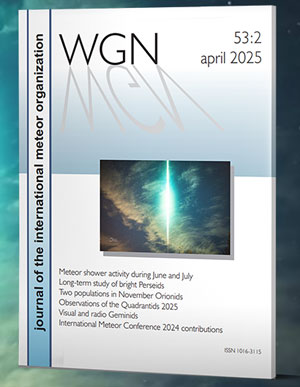On August 12, the BRAMS team has officially launched the Radio Meteor Zoo, a Citizen Science project organized in collaboration with scientists from Zooniverse: http://www.radiometeorzoo.org.
Radio meteor echoes coming from BRAMS
The goal is to ask many people to detect meteor echoes in the BRAMS spectrograms during some meteor showers. This is an easy task that any person can do after reading a short tutorial: just a few mouse clicks to draw a rectangle around every meteor echo. And it’s fun to do!
BRAMS (Belgian RAdio Meteor Stations) is a network of radio receiving stations using reflection of radio waves on meteor trails to detect and characterize meteoroids falling into the Earth’s atmosphere.

Every day a huge amount of data is produced by the BRAMS network with thousands of meteor echoes registered. The data are presented as images (called spectrograms) and automatic detection algorithms try to detect specific shapes associated with meteor echoes. However, none of them can perfectly mimic the human eye which stays the best detector. The problem is particularly striking during meteor showers, occurring when the Earth is passing through a cloud of dust particles left behind by a comet when it approaches the Sun. Many meteor echoes with complex shapes are then observed in the spectrograms. The Radio Meteor Zoo project starts with data from the Perseids 2016 (peaking around August 11-12) with dust particles belonging to comet Swift-Tuttle. We request the help of many eyes from citizen scientists around the world. Your help is invaluable! People from all over the world and of all ages are welcome to participate. Whether you love meteors, astronomy, or just helping out, come join the Radio Meteor Zoo today and discover the fascinating world of dust from space.
It is essential for this project that as many people as possible join the effort. You would help the BRAMS team a lot if you advertise this project to your relatives and friends, and to any astronomy club you may be affiliated with. Thanks in advance for your support!
Your meteor detections will be used to determine how many particles enter the Earth’s atmosphere per hour, to determine the peak time of meteor activity, to estimate the size distribution of the particles, and to compute trajectories of particles using data from multiple BRAMS receiving stations. You’re also invited to chat with researchers and other users on Radio Meteor Zoo Talk. The team is looking forward to working with you!
Get involved right now at http://www.radiometeorzoo.org!
Cis Verbeeck in the name of the Radio Meteor Zoo team




 You saw something bright and fast? Like a huge shooting star? Report it: it may be a fireball.
You saw something bright and fast? Like a huge shooting star? Report it: it may be a fireball.  You counted meteors last night? Share your results with us!
You counted meteors last night? Share your results with us!  You took a photo of a meteor or fireball? You have a screenshot of your cam? Share it with us!
You took a photo of a meteor or fireball? You have a screenshot of your cam? Share it with us!  You caught a meteor or fireball on video? Share your video with us!
You caught a meteor or fireball on video? Share your video with us!